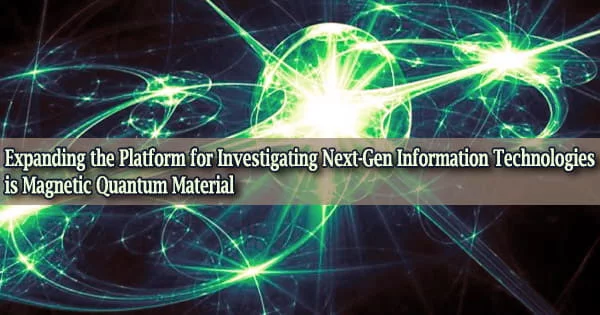Researchers at the Department of Energy’s Oak Ridge National Laboratory to examine if employed neutron scattering the atomic structure of a particular material could support the existence of a brand-new state of matter known as a spiral spin liquid.
The scientists discovered the first 2D system to host a spiral spin liquid by monitoring minute magnetic “spins” on the honeycomb lattice of a layered iron trichloride magnet.
The discovery offers a platform for further research into physics events that could power future information technology. These include skyrmions, which are unique magnetic spin patterns that can promote high-density data storage, and fractons, which are collective quantized vibrations that might show promise in quantum computing.
“Materials hosting spiral spin liquids are particularly exciting due to their potential to be used to generate quantum spin liquids, spin textures and fracton excitations,” said ORNL’s Shang Gao, who led the study published in Physical Review Letters.
According to a long-held idea, the honeycomb lattice can support a spiral spin liquid, a new phase of matter where spins form fluctuating structures resembling corkscrews.
However, there was no experimental proof of this phase in a 2D system prior to the current study. A layered crystalline material makes up a 2D system, and interactions there are stronger in the planar direction than the stacking direction.
Gao chose the more than ten-year-old iron trichloride as a good testing ground for the theory. He asked ORNL colleague Michael McGuire, who has worked extensively on producing and researching 2D materials, whether he would synthesis and describe a sample of iron trichloride for neutron diffraction studies. They were joined by co-author Andrew Christianson of ORNL.
Similar to how 2D graphene layers occur in bulk graphite as pure carbon honeycomb lattices, 2D iron layers also exist in bulk iron trichloride.
It looks like a topographic map of a group of mountains with a bunch of rings going outward. If you were to walk along a ring, all spins would point in the same direction. But if you walk outward and cross different rings, you’re going to see those spins begin to rotate about their axes. That’s the spiral.
Matthew Stone
“Previous reports hinted that this interesting honeycomb material could show complex magnetic behavior at low temperatures,” McGuire said.
“Each honeycomb layer of iron has chlorine atoms above and below it, making chlorine-iron-chlorine slabs,” McGuire said.
“The chlorine atoms on top of one slab interact very weakly with the chlorine atoms on the bottom of the next slab through van der Waals bonding. This weak bonding makes materials like this easily peeled apart into very thin layers, often down to a single slab. This is useful for developing devices and understanding the evolution of quantum physics from three dimensions to two dimensions.”
Electron spins in quantum materials can exhibit unusual collective behavior. Einstein referred to this entangled condition as “spooky action at a distance” if one spin changes.
Because electron spins are always changing and causing other entangled electrons to fluctuate as a result, the system remains in a frustrated state, maintaining chaos. 60 years ago, ORNL carried out the first ferric chloride crystal neutron diffraction research.
Today, cutting-edge studies of magnetic quantum materials are made possible by ORNL’s extensive expertise in materials synthesis, imaging, neutron scattering, theory, simulation, and computation. These studies serve as the foundation for the advancement of next-generation technologies for information security and storage.
Experts and equipment at the Spallation Neutron Source and the High Flux Isotope Reactor, DOE Office of Science user facilities at ORNL, allowed for the mapping of spin movements in the spiral spin liquid.
ORNL co-authors were essential for the success of the neutron scattering experiments: Clarina dela Cruz, who led experiments using HFIR’s POWDER diffractometer; Yaohua Liu, who led experiments employing SNS’s CORELLI spectrometer; Matthias Frontzek, who led experiments engaging HFIR’s WAND2 diffractometer; Matthew Stone, who led experiments operating SNS’s SEQUOIA spectrometer; and Douglas Abernathy, who led experiments working SNS’s ARCS spectrometer.
“The neutron scattering data from our measurements at SNS and HFIR provided compelling evidence of a spiral spin liquid phase,” Gao said.
“The neutron scattering experiments measured how the neutrons exchange energy and momentum with the sample, allowing the magnetic properties to be inferred,” said co-author Matthew Stone.
He described the magnetic structure of a spiral spin liquid: “It looks like a topographic map of a group of mountains with a bunch of rings going outward. If you were to walk along a ring, all spins would point in the same direction. But if you walk outward and cross different rings, you’re going to see those spins begin to rotate about their axes. That’s the spiral.”
“Our study shows that the concept of a spiral spin liquid is viable for the broad class of honeycomb lattice materials,” said co-author Andrew Christianson. “It gives the community a new route to explore spin textures and novel excitations, such as fractons, that then may be used in future applications, such as quantum computing.”





